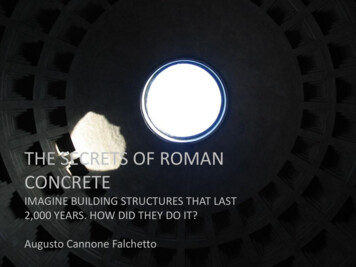
Transcription
ROMANWORKBENCHESbeing a short treatise on benchesFROM POMPEII, HERCULANEUM& THE HOLY ROMAN EMPIREfounded on research & historical reconstructionswith practical applications concerningCONSTRUCTION, WORKHOLDING,PLANING, SAWING, JOINERY &c.fully & clearly explainedBy CHRISTOPHER SCHWARZwith 14 illustrations byNICHOLAS MOEGLYLOST ART PRESS, FORT MITCHELL, KENTUCKY, USA
Roman WorkbenchesPublished by Lost Art Press LLC in 201726 Greenbriar Ave., Fort Mitchell, KY 41017, USAWeb: http://lostartpress.comCopyright 2017 by Christopher SchwarzEditor: Megan FitzpatrickCopy editor: Kara Gebhart UhlResearch: Görge Jonuschat, Suzanne Ellison, Jeff BurksIllustrations: Nicholas Moegly, nicholasmoegly.comDistribution: John HoffmanAll rights reservedNo part of this book may be reproduced in any form or by any electronic ormechanical means including information storage and retrieval systems withoutpermission in writing from the publisher, except by a reviewer, who may quotebrief passages in a review.This book was printed and bound in the United States of AmericaPrinted by Steam Whistle Letterpress (steamwhistlepress.com) in Newport, Ky., on a Vandercook 425 proofing press using polymer plates from BoxcarPress (boxcarpress.com). The paper is Mohawk Via Laid 70t. natural. The bookwas sewn and bound by Acme Binding in Charlestown, Mass. The font usedthroughout is Adobe Caslon Pro.
TABLE OF CONTENTSIntroduction1. Pay No Attention to the Cow CostumeTo the RuinsThe Pompeii WorkbenchMeanwhile, at HerculaneumA Pause to Praise ResearchersAnd Back to HerculaneumSlabs of Wet OakStop Start StopThe Saalburg WorkbenchRoman Holdfasts1569101113141516172. Build the Herculaneum Workbench193. ‘Auf Wiedersehen’ to Your Dollars31True the Slab & Turn the LegsSplayed Legs & the Easy Way OutAssembly & WedgingTrim the LegsThe Benchtop’s Peg Holes / Use the Roman WorkbenchFaces of BoardsEdges of Boards / Ends of Boards – JoineryOther HelpersEnter the GörgeWhy so Quiet, Mr. Spoonwood?Who Was Martin Löffelholz?19202325262729303435364. The 1505 Holy Roman ive SlabsLay Out the MortisesTenons / Assembly / The Face ViseThe Vise ScrewsThe End ViseDog & Holdfast Holes / Details on Use404244454650
LIST OF ILLUSTRATIONSFig. 1: Perdix at his benchFig. 2: The fresco at HerculaneumFig. 3: The Saalburg workbenchFig. 4: Roman holdfastFig. 5: Construction details of the Herculaneum benchFig. 6: Use sightlines and resultant anglesFig. 7: The half pencilFig. 8: Layout of peg holesFig. 9: Using pegs for planing edgesFig. 10: The 1505 workbench and viseFig. 11: Northern Italian bench from the 14th centuryFig. 12: Plan view of the 1505 benchFig. 13: Elevation of the 1505 benchFig. 14: Metalwork for the 1505 bench47141720212425283240414347
IntroductionFor many woodworkers, the workbench is an unwilling storebought accomplice that we trick into doing our will. It’s an appliance, such as a toaster oven or food processor, that we then pressinto doing the job of a “heat-treating furnace” or “mouse punisher.”As a result of these crappy commercial benches, every operationis a struggle. And when the woodworker sells his or her house, thissort of bench is often left behind to flummox its new owner.Real workbenches adapt and anticipate your work. These flexibleand simple forms were developed during the last 2,000 years whennothing was made of plastic and almost everything was made ofwood. Wondrous and nearly forgotten, these alien benches are whatkeep me digging through old manuscripts and setting out to build“one more oddball workbench.”Since 1999, I have researched and built dozens of workbenchesfrom different time periods to see if they work in a modern shop.From the 18th century, I built the monolithic “Roubo” workbench,1usually associated with French work. This bench opened my eyes asto how simplicity – many of these benches have no vises – could beused for complex furniture work.During that research I also found an English variant (the “Nicholson”) that performed all the operations of the Roubo workbenchbut required half the amount of lumber to build. It’s a great benchfor an island nation with limited forests.But after building these workbenches, which I love, I realized I’dtaken but a small step. There was still about 1,600 years of recordedhistory yet to explore.1For more on French and English benches see “Workbenches: From Design & Theory to Construction & Use. Revised Edition” (Popular WoodworkingBooks).
2ROMAN WORKBENCHESSo I went back as far as I could, to the Egyptians. That civilization invented most of the woodworking tools and joints we usetoday, but as far as I know its woodworkers didn’t use a workbench(at least what we would consider a workbench). I’ve seen tombdrawings of boards lashed upright for ripping with a saw, and I’veseen drawings of rocks with notches in them that could be usedfor holding the work with the assistance of the human body. Butelevated strong worktables? Nope.The first workbenches I’m aware of are from the excavations oftwo cities, Pompeii and Herculaneum, which were destroyed whenMount Vesuvius erupted in A.D. 79. Roman paintings (and engravings of paintings) show workbenches that are lightweight, simplerand (at times) far lower in height than a contemporary workbench.These benches have fascinated me for years. I wondered: For howlong was this form of workbench dominant? Could you performcomplex joinery operations on it? Could you process boards forlarge-scale cabinetry? Could you work on the faces, edges and endsof boards with ease?The only way to answer my questions was to build those benches.So after gazing at about a dozen examples, I chose two workbenches for this book. The first is based on the A.D. 79 workbenchshown at Herculaneum. It’s an eight-legged beast with a holdfast.It’s narrow (about 15") and only knee-high. This Roman-style benchhad much to teach me about workholding because it shows whatyou can do with only a series of staggered holes, a few wooden pegsand two butt cheeks.The second workbench in this book is what I consider the first“modern” bench. It has a Roman undercarriage much like thebenches from Herculaneum and Pompeii. But its benchtop is revolutionary.Martin Löffelholz, the man who likely drew this bench circa1505, knew something about woodworking, wooden screws and escaping from his captors while urinating (more on that skill later).His two drawings of woodworking benches show a fully functionalend vise, a series of dog holes and a twin-screw face vise. No buttcheeks needed.While I know of a 14th-century Italian drawing of workbenches
INTRODUCTION3with screw-driven faces vises, Löffelholz’s bench is, as far as I know,the first workbench that has both a face vise and an end vise.Both of these benches are far simpler than the workbenches thathave been dominant for the last 300 years. The joinery to makethem is but slightly more complex than drilling a hole and thendriving a stick into said hole. The benches have no stretchers between their legs, no dovetails and no square mortise-and-tenonjoints. I think that the only thing simpler than building one of thesebenches would be to find a workbench-shaped rock.The following chapters tell a somewhat twisty tale of researching,building and using these workbenches. You’ll hear how we flusheda bunch of money down the toilet. And about the time we thoughtwe had caught a bench on fire. Oh, and I hope you aren’t offendedby Roman penises.I hope this short book will grant you a few workholding tricksyou can use in the shop, give you a peek at how ingenious the Romans were and – just maybe – convince you that the simplest of allworkbenches can be used to build complex and beautiful pieces offurniture.
Figure 1: Perdix cuts a mortise at his bench, ignoring the “cow” behind him.
chapter 1Pay No Attention to the Cow CostumeIt’s a bright summer day in Blue Hill, Maine, and I’m stalkingaround the house of the long-dead Jonathan Fisher to see what Ican make of the man.Fisher (1768-1847) was a Congregational minister who did woodworking on the side to make ends meet in early Maine. He hadthe kind of mechanical mind that thinks it’s perfectly reasonable tobuild a wooden clock while attending Harvard. Or to hook up yourwindmill to your lathe.But what interested me most during my afternoon visit to hisresidence was a crude and low bench that looked like it belongedin a barn. Like many vernacular pieces, this bench was made with“staked” construction. (Here’s a Ph.D. in staked furniture: Drillthree or four holes in a plank and ram a leg into each hole. Fin.)Fisher’s bench resembles hundreds of benches I’ve seen in castlesand hovels all over the globe. But for some reason the pattern ofholes in that particular bench’s seat worked like alien crop circleson my brain. While at first glance the holes look like a naughtychild had ventilated the seat out of boredom, I knew I had seen thispattern before.I blurted out to no one in particular: “It’s a Roman workbench.”It was obvious. The holes receive pegs that restrain planks of woodwhile you work them. I’d seen this pattern in 1950s Estonian texts,15th-century drawings from the “Die Hausbücher der NürnbergerZwölfbrüderstiftungen” collection, Pompeii, Herculaneum and atleast a dozen other places throughout the time line of civilization.But it wasn’t until seeing Fisher’s bench that I connected the dots
6ROMAN WORKBENCHESbetween the Roman benches from A.D. 79 and the contemporaryexamples I’d stumbled upon.This “Roman” bench form might have gotten its start in Rome.But like spaghetti, it can be found – with a local twist – in every culture and time period. I’ve seen it in modern-day Mexico equippedwith loonily long vise screws projecting out the side (which I’m stilltrying to figure out). The Chinese still use a bench like this for allsorts of woodworking.In other words, this style of bench has been around for at least2,000 years. But modern woodworkers (myself included) wereblind to it because to us a workbench is a 38"-tall strong worktablewith stretchers, screw-driven vises and maybe a tool tray.TO THE RUINSAfter this encounter fermented for a few days, I took a seriouslook at the Roman workbench images from Pompeii and Herculaneum that had been hibernating on my hard drive. After somestudy, the biggest question in my mind was this: Were they just alow place to work for specialized operations, such as mortising, orcould you perform complex joinery operations on them?I started by examining the workbench painted on a wall in theHouse of the Vettii in Pompeii. The image itself is clear, the storybeing depicted in the painting is famous and the bench is as simpleas you can get: four legs and a slab top.For those who aren’t familiar with Pompeii, the House of theVettii is one of the most famous restored residences in the ruinedcity and attracts a lot of tourists, despite Priapus.OK, let’s pause before we discuss Priapus and the frescoes in theHouse of the Vettii. If you are someone who is upset by graphicsexual imagery you should shy away from Roman art. Put anotherway: If you think Cinemax shows dirty films, avoid Roman historyand study something more conservative, such as 1970s porn.The Roman attitude toward sexuality is absolutely unhingedcompared to modern mores. While we might blush at the idea ofan orgy, the Romans would clamor for more “man-on-goat” action.I say all this because puritanical attitudes toward sex have occa-
PAY NO ATTENTION.7Figure 2: The bench fresco from Herculaneum is mired in controversy.sionally derailed scholarship on Roman culture. Many of the findsfrom Pompeii and Herculaneum that were deemed filthy were sequestered in the “Gabinetto Segreto” (the Secret Museum), a gallery in the Museo Archeologico Nazionale in Naples. This important archaeological gallery has been open only intermittently to thepublic since the objects were collected in 1821 (in 1849 they actuallybricked over its entrance). Since 2000 it has been (generally) opento everyone.So (OK, I’m serious now, prudes should stop reading) when youwalk into the House of the Vettii in Pompeii you are greeted byan image of Priapus, a minor god of fertility and genitals, who isweighing his penis against a bag of coins. It’s a symbol of prosperityand fertility presented by the house’s owners, two freed slaves whohad become quite wealthy.And if you think that the skin show ends after you leave theentranceway, you would be wrong. Graphic depictions of sex areeverywhere in the House of the Vettii and in Pompeii in general.
8ROMAN WORKBENCHESSo you might feel some small relief after you pass through themain hall and courtyard where you can take a peek at a room calledthe “red oecus” – a formal dining room. In this room are some of thehouse’s best frescoes, including one of Daedalus presenting a cowcostume that he built for Pasiphaë, the wife of King Minos.In the extreme foreground of the image is Perdix (Daedalus’nephew and apprentice), who is mortising a post or leg. His workis restrained with iron nails – Romans made tons of them – and itrests upon a low workbench with four splayed legs.So there you have it: the beautiful Pasiphaë, Daedalus, a cowcostume and young Perdix bashing out a mortise. But if you lookclosely at Perdix’s facial expression, you might see what I see. He’soblivious to the scene behind him. He might, in fact, be trying toshut it out from his consciousness, like my kids holding their earsand chanting “nunga, nunga, nunga” to deny the call for bedtime.So Perdix, why the thousand-yard stare? Don’t you approve ofPasiphaë’s cow costume?Wait, why does Pasiphaë want a custom cow costume?I’ll be honest here. My education in Greek and Roman myth wasa bit lacking, so I asked researcher Suzanne Ellison to fill me in onthe cow costume. She gave it to me in gentle terms, which I willreproduce here for the sensitive.Pasiphaë had been cursed by Poseidon to have carnal affectionsfor a particular bull. To satisfy those urges, she required a cow costume. Enter Daedalus, the inventor of carpentry, ship masts andglue. He built the cow costume and, after a magical night, Pasiphaëgave birth to the half-man, half-bull we call the Minotaur.2So Perdix is keeping his eye on the mortise, or perhaps he isthinking about how he’s going to invent the saw, compass and chisel (before Daedalus tries to kill him and he turns into a partridgeand.3). And we are left to ponder the bench he is sitting on.2So Suzanne says I’m giving short shrift to the woman in the story andpetitioned me to add: “Here’s a bit more about Pasiphaë’s story. She was a daughter of Helios, the Sun god. Minos was a son of Zeus. Poseidon and Zeus wereoften at loggerheads. When King Minos refused to offer a prized white bull insacrifice to Poseidon, the sea god retaliated by cursing Pasiphaë and causing herto lust after the bull. The monstrous offspring that resulted, half-human andhalf-bull, was an abomination to Minos.”
PAY NO ATTENTION.9THE POMPEII WORKBENCHSo here’s what I see when I look at Perdix’s workbench. It’s aboutknee-high, so Perdix is sitting down. We don’t see exactly whathe is sitting on. It could be a stool, or perhaps he is supposed to besitting on the work and the perspective is decidedly pre-perspective.The work itself is restrained by at least two Roman nails that arepounded into the benchtop. And this is the first workholding tipfor modern users: You can drive nails into your benchtop to securethe work. It’s not my first choice when figuring out how to managean odd-shaped workpiece. But I do it fairly regularly when I getbacked into a corner. Sometimes you need the work secured to thebench with nothing sticking up above the work (if you use routersin your work I hope you are nodding in agreement; otherwise it’sthe cow costume for you).This bench has four legs that are splayed out toward the cornersof the benchtop. This is a fairly typical Roman representation ofsplay. Yes, I know it looks like the front legs lean left and the rearlegs lean right. But after you look at a lot of early images, this is theway they represented rake and splay. The artist is, in my opinion,trying to represent both the elevation view and the profile view ofthe bench.On the ground we have a bow drill and a sort of adze that couldhave been used for face- or edge-planing the work.Then we have Perdix himself with a faraway look in his eye anda Roman hammer in his right hand.When I first saw this image I assumed Perdix was using a mortising stool. It wasn’t until I dove into untangling the image of aworkbench from nearby Herculaneum that I decided Perdix wasworking at a workbench on which he could build almost anything.3Daedalus pushed Perdix from a tower. But Athena, who saw it happen,turned Perdix into a partridge before he hit the ground. Why a partridge? Thebird lives in hedges, not in trees, and avoids flying too high.
10ROMAN WORKBENCHESMEANWHILE, AT HERCULANEUMHerculaneum is about a 20-minute drive northwest of Pompeiiand was destroyed by the same volcanic eruption in A.D. 79.While Herculaneum was wealthier than Pompeii and was rediscovered earlier than its more-famous neighbor, its contribution to ourwoodworking knowledge is somewhat flawed and uncertain.Many of the artifacts from Herculaneum have disappeared due topoor excavation or conservation methods, including the image I amobsessed with: Two “erotes” (what we might call cupids) working onan eight-legged workbench that includes holes in the benchtop anda holdfast. It is the earliest image of a holdfast of which I am aware.The original image of this woodworking scene was removedfrom the House of the Deer (Casa dei Cervi) in 1748. It was firstdeposited in the royal palace at Portici and what remains is nowat the Museo Archeologico Nazionale di Napoli. For a variety ofreasons (exposure to air and damp, haphazard storage and conservation methods and the way the fresco was made) by 1879 the workbench image had deteriorated to the point where the erotes haddisappeared, according to Hugo Blümner’s book “Technology andTerminology of Trade and Art of the Greeks and Romans.” All wehave left of the original painting are 18th-century copperplate engravings that were distributed all over Europe and England – manyof them conflicting in their details.So because we cannot see the original painting anymore, thatleaves us with a question: How accurate are these 18th-century copperplate engravings?It was the same sort of question that 18th-century researcherswere asking when they saw the copperplate representations of thepaintings and couldn’t afford to travel to Italy to view the originals.While visitors who saw the paintings in person were impressed,some foreign writers were skeptical.“(T)hat the artists who were employed at Herculaneum, were ofan inferior rank, is plain from their excelling chiefly in little subjects, as ornaments, animals &etc.; a sure sign of a mediocrity of genius. These paintings were all executed upon the spot, and thereforeprobably not done by the best hands,” according to the first English
PAY NO ATTENTION.11translation of “The Antiquities of Herculaneum” (1773) by ThomasMartyn and John Lettice.But after studying the engravings and the original paintings thatdid survive, it’s clear that the Italian artists were meticulous in preserving the details of the paintings. Suzanne and I compared morethan a half-dozen paintings that have survived to their engravings(all executed by the same 18th-century copperplate artist) and concluded that the engraver took almost no artistic liberties when representing the paintings.The same, however, cannot be said for the Western Europeanengravers who copied the Italian engravers. As the images of thesepaintings spread across Europe the details became muddied. Inthe example of our workbench painting, the bench lost its holdfastholes, it lost four legs, the saw moved and the holdfast disappeared.Additionally, several poor translations of the Italian text describing the paintings amplified the misinformation.How do I know all this? From hundreds of images that havebeen dug up by the researchers who help me.A PAUSE TO PRAISE RESEARCHERSAs a lifelong journalist, I’m fairly good at digging through historical texts, making sense of them and then putting them tomusic with fart jokes. But my research – such as it is – would beless rich if I didn’t have the help of Suzanne Ellison and Jeff Burks.I often refer to them as researchers for Lost Art Press. But thatreally doesn’t capture their doggedness. They are more like historical inquisitors. And here’s the funny thing: I barely know either ofthem.Here’s what I do know. Jeff is a lifelong professional woodworkerwho lives in Connecticut. He became interested in old texts whileworking on a crew specializing in high-end trim carpentry. Hewatched them install difficult work – think curved and compoundmiters – through lots of trial, error and waste.Jeff thought there might be a book at the library that could helpthem figure this stuff out. He was correct, and thus began his longrelationship with the historical woodworking record, from collect-
12ROMAN WORKBENCHESing 19th-century newspapers for the trades to learning the fundamentals of several languages so he could search European culturalarchives that are online.If you’ve been to a few woodworking shows, there’s a chanceyou’ve been in the same room with him. It’s unlikely, however, thatyou’ve met him. He rarely makes a scene and walks around with acamera near his waist, taking candid photos to record the tools anddemonstrations.Somehow during an event at Popular Woodworking Magazine, wehad a conversation and I latched onto him like a saber-toothedinformation leech. During the years I’ve known him he’s sent methousands of images he’s culled from online archives and books.Sometimes when I’m trapped on an airplane or at the doctor’s office I’ll pull out my laptop and start paging through them. There areat least 100 books I could write using those images. And Jeff findsmore images all the time.The funniest thing about Jeff is that many people don’t believehe exists. They suggest that he’s a figment of my frontal lobe. But Iassure you he does exist. Other people can back me up.Our other researcher is Suzanne Ellison. She’s a retired analystfor a global cargo airline who has a longstanding love of art andhistory. She spends a lot of time engaging in the kind of researchthat few people do. First she translates the texts. Then she’ll writeor call anyone in the world to resolve her unanswered questions.I first ran into Suzanne when she offered to write an index formy book “The Anarchist’s Tool Chest.” She’s not a woodworker,but she had purchased a copy for her brother. After reading it, shesent me an email that said: “Hey, you need an index.” I agreed, andshe sent me an index that made me laugh out loud because it was abit silly in places and referenced tube tops. I fell for her.That was more than five years ago. We’ve been in constant contact ever since. Oddly, I’ve met her in person only once – for breakfast in Maryland after I’d finished teaching a class. It was a funmorning, and I ended up with a lot of crab memorabilia.While Jeff is like a fisherman who works with big nets, Suzanneis like a French fur trapper. She is relentless in following a trail untilshe finds the image, the date or the academic she needs (who she
PAY NO ATTENTION.13then charms into turning over his or her research). Like Jeff, shemoves easily between Italian, French, German and even some ofthe languages in the low countries.I don’t deserve to work with either of them. They refuse to bepaid for their research, so I sometimes send them boxes of stuff. Suzanne is gracious and responds with a nice handwritten “thank you”note. Sometimes I wonder if Jeff throws my boxes in the dumpster.AND BACK TO HERCULANEUMSo the workbench from Herculaneum – Suzanne calls it the“falegname” (Italian for “carpenter or joiner”) fresco – is troubling. The original painting is kaput. But the engravings of thefalegname fresco are so tantalizing that I couldn’t ignore them.At some point during the four years we worked on this book,Suzanne and I decided to take the early Italian engravers at theirword. We accepted that the workbench in the falegname fresco haseight legs. It has a holdfast and a series of holdfast holes. And theframe saw makes no sense – the blade shouldn’t be in the middle ofthe frame. (But I’m going to leave this detail to someone who wantsto write a monograph on frame saws.)This wasn’t an easy decision to make. A lot has been writtenabout this woodworking scene, and some educated people contendthat the image doesn’t depict a workbench. Instead, we’re lookingat two sawhorses. Some work is placed on top of the sawhorses. Yes,there is a holdfast. But it’s really a depiction of two sawbenches (orsawbucks).Because we now know a lot more about low benches in Naples,Saalburg, Estonia and China (to name a few) I can safely disagree.It’s a bench with eight legs (why eight legs? Who knows). Andthere’s a piece of work on top of the bench.So I decided to build the Herculaneum bench because it offeredmore unanswered questions than the one pictured at Pompeii. Andhey, I’d be the first person in my neighborhood to build an eightlegged bench.The day I made that decision, I started sending emails to NorthCarolina.
14ROMAN WORKBENCHESSLABS OF WET OAKThough I’m surrounded by hardwood forests in Kentucky, it’sbeen difficult to find thick slabs of wood that are wide andlong enough for building ancient workbenches. (I have since founda local source of slabs, which proves that you simply need to keeplooking – it took me only 21 years.)But in early 2016 I needed slabs of a certain size that would beready at a certain time. So I called Will Myers.Will runs an automotive body shop in North Carolina duringthe day and is an enthusiastic woodworker for the rest of his wakinghours. I first met Will when he showed up at a class I was teachingat Roy Underhill’s school, and he was hauling a much-needed loadof pure beeswax he had harvested.Will and I worked together at both sessions of the bench-building event in Georgia called the French Oak Roubo Project. We’reboth Southerners. We both drink beer. So I do not need to say anymore about our relationship.Oh, I also knew that Will knew a sawyer who was happy to sawbig slabs of oak – up to 6" x 24" x 8'– for a reasonable price. Aftersome back-and-forth, Will agreed to work with the sawyer, LesleyFigure 3: The Saalburg workbench is the earliest surviving bench known.
PAY NO ATTENTION.15Caudle, to cut and dry some slabs for both workbenches in thisbook.Will insisted on using red oak because it is easier to dry thanwhite oak and many other species. The fact that red oak dries without massive distortions or checks is the nicest thing I can say aboutit. Red oak is the “has a great salad bar” or “but is a really greatdancer” of the hardwood world.The slab Will and Lesley cut and dried for the Herculaneumbench measured about 4" x 16" x 85". It was bone dry after a spell inWill’s homemade kiln. (The slab for the other bench in this book,however, refused to dry. More on that slab later on in the book.)Will and Lesley also cut some red oak stock for the bench’s legs.But when I came to pick up the wood, I forgot to throw it in myrented van. So instead I used some white oak left over from otherprojects for the eight legs. The legs ended up 2" in diameter x 22"long, so you can use 8/4 rough stock for your legs and get the sameresult.STOP START STOPWhen I build projects such as the Herculaneum workbench,I don’t stick to a strict construction drawing – I stick to thehistorical images. I start with a good sketch and a cutting list. Butas I take each step forward in building the project I compare myresults to the images I have on hand.Does this look right? Am I off the rails?I know I’m an odd sight to the people who walk by my shopwindow, but I spend hours at my bench staring at historical imagesI’ve printed out. I draw on the printouts. I scrawl my questions inthe margins. Then, when there’s nothing left to argue about in myhead, I pick up my brace and walk to the waiting slab to make onequick hole that will determine the next two weeks of work.As I think you’ll see, it’s the holes in this bench that pose themost questions and offer the most insight into early woodworkingpractices.
16ROMAN WORKBENCHESTHE SAALBURG WORKBENCHNot much Roman woodwork has survived – it’s been a longtime since Pax Romana. But thanks to excavations at a Romanfort at Saalburg, which is just north of Frankfurt, we might have alook at a surviving Roman workbench top.The fort was initially investigated in the mid-19th century thenrebuilt between 1897 and 1907 as an open-air museum.The museum houses many Roman artifacts, including woodworking tools, plus (surprisingly) Roman objects made from woodand leather, which were preserved in wells at the fort.I first learned about this benchtop from W.L. Goodman’s “TheHistory of Woodworking Tools” (1964), which quoted work byGerman woodworking historian Josef M. Greber.Greber drew an oak benchtop measuring 4" x 12-1/4" x 101-1/2".It has four mortises for splayed legs, a mortise for a planing stopand two notches on one long edge that could be there for a varietyof reasons. My suspicion is they were used like a brake is used onprimitive workbenches. The worker would place the work in thenotch and wedge it in place to saw a tenon, for example.The slope of the mortises in the top suggest the bench was lowand used while sitting down. In fact, at some point the museum hadadded four square legs to the original top, which confirms it wasalmost certainly a low workbench.As far as I know this is the oldest surviving workbench in theWestern world, and thanks to photographs and museum accountswe also know it was a well-used item.Side note: Tw
from different time periods to see if they work in a modern shop. From the 18th century, I built the monolithic “Roubo” workbench,1 usually associated with French work. This bench opened my eyes as to










